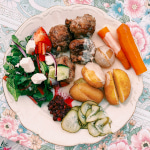Meatball Day in Sweden Date in the current year: August 23, 2026
 Meatball Day (Köttbullens dag) is celebrated in Sweden on August 23 every year. The holiday was created in honor of one of the most iconic dishes of Swedish cuisine.
Meatball Day (Köttbullens dag) is celebrated in Sweden on August 23 every year. The holiday was created in honor of one of the most iconic dishes of Swedish cuisine.A meatball is ground meat rolled into a ball, sometimes along with other ingredients, and then cooked by frying, baking, steaming, braising in sauce, or boiling in soup. There are many different types of meatballs found in various cuisines across Europe and Asia.
In Sweden, meatballs (köttbullar, literally “meat buns”) are a popular home-cooked comfort food, and they are widely regarded as one of the country’s national dishes. Swedish meatballs are usually made from a mix of ground beef and ground pork; the fat in the pork makes them juicy while the beef makes them leaner than all-pork meatballs. In southern Sweden, they often contain more pork, while in northern Sweden, more beef is used. Other types of meat, such as veal or venison, can also be used to make meatballs.
Other ingredients added to the mince to make Swedish meatballs include breadcrumbs soaked in milk or another liquid, beaten eggs, grated raw onions or finely chopped fried onions, and sometimes cream. The mince is usually seasoned with salt, white pepper, and occasionally allspice. The meatballs are usually small, around 2–4 centimeters in diameter.
In Sweden, meatballs are typically served with gravy or cream sauce, mashed or boiled potatoes, lingonberry jam, and pickled cucumbers. They can also be served with pasta (a common meal for children) or on a sandwich, often on a bed of beetroot salad. The köttbullar are a common dish on the Swedish Christmas table (julbord).
The origin of Swedish meatballs is unclear. In 2018, the Swedish Institute claimed that the dish was brought to the country by King Charles XII when he returned to Sweden from his five-year stay in the Ottoman Empire in the early 18th century. However, some food historians disagreed, claiming that the meatballs likely originated in Italy or France. In the end, there is not enough evidence to either support or refute any of these theories.
The first recorded mention of Swedish meatballs can be found in the famous cookbook Hjelpreda i Hushållningen för Unga Fruentimber (Helpful Guide in Housekeeping for Young Women), written by Cajsa Warg and first published in 1755. Warg’s recipe included minced meat (veal, mutton or beef), breadcrumbs, eggs, pepper, salt, and nutmeg.
Meatballs didn’t gain popularity in Sweden until the mid-19th century, when meat grinders and wood stoves became more commonplace in Swedish households. Most early meatball recipes published before the beginning of the 20th century did not include onions. Today, however, most recipes include onions. The Swedish version of meatballs became popular globally thanks to IKEA’s restaurants and cafes, where meatballs are a staple. In 2019, IKEA sold one billion meatballs to customers worldwide.
It is unclear who and when came up with the idea of celebrating Meatball Day on August 23, but does it really matter? What matters is that you have a great excuse to enjoy some delicious meatballs, even if you’re not in Sweden.
- Category
- Unofficial Holidays
- Country
- Sweden
- Tags
- Meatball Day, holidays in Sweden, food days, unofficial holidays, Swedish meatballs, Swedish cuisine